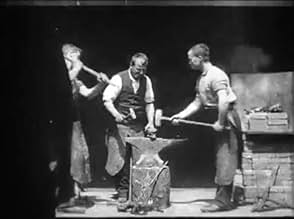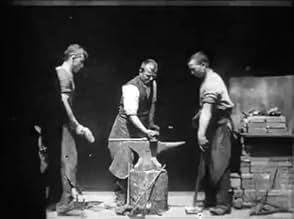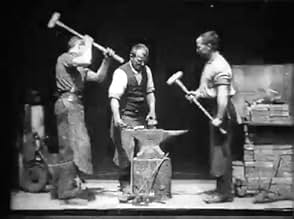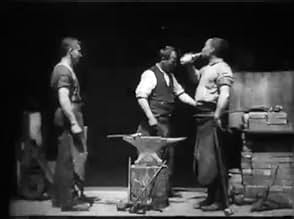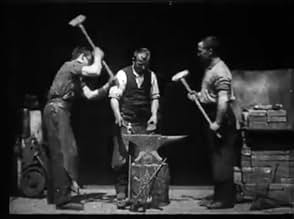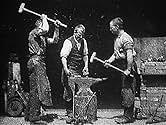PUNTUACIÓN EN IMDb
6,2/10
3 mil
TU PUNTUACIÓN
Tres hombres con un martillo y una botella de cerveza.Tres hombres con un martillo y una botella de cerveza.Tres hombres con un martillo y una botella de cerveza.
- Dirección
- Reparto principal
- Premios
- 1 premio en total
Charles Kayser
- Blacksmith
- (sin acreditar)
Reseñas destacadas
'Blacksmith Scene (1893)' was one of the first commercially-exhibited motion pictures, filmed in April 1893 and first screened publicly at the Brooklyn Institute on May 9, 1893. The set-up is pretty simple: three blacksmiths (actually employees of Thomas Edison) start hammering away at a heated metal rod and an anvil, before pausing to pass around a bottle of beer. The acting from two of the performers is convincing enough; the third blacksmith, on the left, doesn't even pretend that the beer bottle contains any liquid, briefly pressing the rim to his mouth and then removing it without even the pretence of drinking. The film's first seven seconds have the silhouette of a fourth party blocking the left side of the frame, before somebody presumably told him to get out of the way. While watching this didn't give me the same thrill as the Lumière brothers' 'Arrival of a Train at La Ciotat (1895),' 'Blacksmith Scene' is still an important historical curiosity. I'm grateful that the National Film Registry always remembers to honour and preserve even these apparently-innocuous snippets of cinema history.
The footage in this very early movie still looks very good, and it still works as a vignette (albeit a staged one) of life in a bygone era. In itself, it's a simple scene, but it's far from a lifeless one, and the composition works as well.
The scene, which features the leisurely-paced efforts of the blacksmiths as they do their work while occasionally refreshing themselves, is not without a little irony. Even in its day, although the blacksmith shop itself was a familiar sight, the laid-back feel of the scene was deliberately imagined as a throwback to an earlier day, rather than as a picture of the (then) present of the 1890s. (The notes in the new Kino collection of Edison films confirm this.) By contrast, many of the other earliest movies were made with a deliberate emphasis on things of the present.
The images still look quite clear in comparison with some of the other experiments in the earlier 1890s, so it must have looked quite good in its time. Then, it was an intriguing taste of things soon to come. Now, it is a chance to revisit the past.
The scene, which features the leisurely-paced efforts of the blacksmiths as they do their work while occasionally refreshing themselves, is not without a little irony. Even in its day, although the blacksmith shop itself was a familiar sight, the laid-back feel of the scene was deliberately imagined as a throwback to an earlier day, rather than as a picture of the (then) present of the 1890s. (The notes in the new Kino collection of Edison films confirm this.) By contrast, many of the other earliest movies were made with a deliberate emphasis on things of the present.
The images still look quite clear in comparison with some of the other experiments in the earlier 1890s, so it must have looked quite good in its time. Then, it was an intriguing taste of things soon to come. Now, it is a chance to revisit the past.
This early movie perfectly demonstrates the future possibilities of motion picture.
The quality of the movie is surprising good looking. There are no jerky movements and the colors are clear to see, as is the entire picture as a whole. Sorts of makes you wonder why movies from the 1910's and '20's were so much worse looking compared to these early Edison Manufacturing Company films, from the end of the 19th century, when it comes down to the visual quality of the images. Of course it has to do everything with different (and cheaper and more simple to make) camera techniques and projecting being used, among other reasons.
The movie shows three hard working blacksmiths hammering on an anvil, one at a time, each on a other side. When they're done they're thirsty and pass a bottle of beer, before resuming their work. Funny to see that the beer bottle itself was obviously empty. The third guy that got the bottle didn't even bothered to do as if he took a sip. He simply putted the bottle against his lips and then quickly putted it back on its place.
It's a studio shot movie (shot at Black Maria studio at West Orange, New Jersey, America's first movie studio, built on the grounds of Edison's laboratories), meaning that the person's are 'actors' (actually of course just Edison employees) and the events are staged. The movie shows all of the possibilities of movie making. It has lots of individual movements from 3 separate persons and 'action' in it, since there are several things happening within the 30 seconds.
I'm sure this movie must have really thrilled people to see all of the possibilities of motion pictures, when it was first publicly shown at the Brooklyn Institute in 1893.
8/10
http://bobafett1138.blogspot.com/
The quality of the movie is surprising good looking. There are no jerky movements and the colors are clear to see, as is the entire picture as a whole. Sorts of makes you wonder why movies from the 1910's and '20's were so much worse looking compared to these early Edison Manufacturing Company films, from the end of the 19th century, when it comes down to the visual quality of the images. Of course it has to do everything with different (and cheaper and more simple to make) camera techniques and projecting being used, among other reasons.
The movie shows three hard working blacksmiths hammering on an anvil, one at a time, each on a other side. When they're done they're thirsty and pass a bottle of beer, before resuming their work. Funny to see that the beer bottle itself was obviously empty. The third guy that got the bottle didn't even bothered to do as if he took a sip. He simply putted the bottle against his lips and then quickly putted it back on its place.
It's a studio shot movie (shot at Black Maria studio at West Orange, New Jersey, America's first movie studio, built on the grounds of Edison's laboratories), meaning that the person's are 'actors' (actually of course just Edison employees) and the events are staged. The movie shows all of the possibilities of movie making. It has lots of individual movements from 3 separate persons and 'action' in it, since there are several things happening within the 30 seconds.
I'm sure this movie must have really thrilled people to see all of the possibilities of motion pictures, when it was first publicly shown at the Brooklyn Institute in 1893.
8/10
http://bobafett1138.blogspot.com/
This is supposed to be the "first staged narrative in film", although it is really better described as one of the "actualities" that Edison's films were known as, and what ultimately, about 20 years later, was their downfall. Actualities really had no story, they were just glimpses into normal life, and sometimes the weird and fanciful, but none really had a story.
Apparently the guy in the middle is an actual blacksmith and the two assistants are actors. Together they hammer on a heated rod placed on an anvil. Afterwards, the three share a bottle of beer. Both actors had long lives. One lived from 1850-1931. The other, Charles Kayser, lived from 1878-1966, which would have made him only fifteen when this film was made. So he would have lived to see movies grow from these actualities, to features, the coming of sound, then TV, then even color TV.
Apparently the guy in the middle is an actual blacksmith and the two assistants are actors. Together they hammer on a heated rod placed on an anvil. Afterwards, the three share a bottle of beer. Both actors had long lives. One lived from 1850-1931. The other, Charles Kayser, lived from 1878-1966, which would have made him only fifteen when this film was made. So he would have lived to see movies grow from these actualities, to features, the coming of sound, then TV, then even color TV.
All right, so it's short on plot. But just the fact of this Edison-studio produced film is enough to make it an award-winner. It doesn't have the same pathos as the Edison clip of men dancing used to such great effect in "The Celluloid Closet," but how can you not love a century-old example of "Miller Time"?
¿Sabías que...?
- CuriosidadesThe mixing of work and alcohol was commonplace in the early 19th century, especially amongst heavy laborers. By the 1890's, however, the practice had died away. The use of the bottle of beer in this film is intended to invoke a sense of comic nostalgia of a bygone era.
- ConexionesFeatured in Edison: The Invention of the Movies (2005)
Selecciones populares
Inicia sesión para calificar y añadir a tu lista para recibir recomendaciones personalizadas
Detalles
- Fecha de lanzamiento
- País de origen
- Idioma
- Títulos en diferentes países
- Blacksmith Scene #1
- Localizaciones del rodaje
- Empresa productora
- Ver más compañías en los créditos en IMDbPro
- Duración1 minuto
- Color
- Mezcla de sonido
- Relación de aspecto
- 1.33 : 1
Contribuir a esta página
Sugerir un cambio o añadir el contenido que falta

Principal laguna de datos
By what name was Blacksmith Scene (1893) officially released in India in English?
Responde

